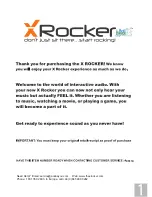
11
i
NETWORK indicator
Displays the network system connection status.
On:
Indicates that an external control device (MSU-1000
Master Setup Unit or RCP-3000/1000 series Remote
Control Panel) is connected when the CNS MODE setting
in <CNS SETTINGS> is set to BRIDGE.
Flashing:
Indicates that an external control device
(MSU-1000 Master Setup Unit or RCP-3000/1000 series
Remote Control Panel) is not connected successfully when
the CNS MODE setting in <CNS SETTINGS> is set to
BRIDGE.
Off:
Indicates that the LAN cable is not connected or network
system connection parameters have not been set when
the CNS MODE setting in <CNS SETTINGS> is set to
BRIDGE.
The indicator is always off when CNS MODE is set to
LEGACY.
For details, see “<CNS SETTINGS>” (page 42).
j
Menu lock switch
Locks the menu control block on the front panel.
k
Assignable buttons
You can assign functions to these buttons from the BPU menu.
Rear Panel
a
REMOTE connector (round type, 8-pin)
Connects to an RCP-3000/1000 series Remote Control Panel
or MSU-1000 Master Setup Unit using a CCA-5 connection
cable. Remote control signals are transmitted and received via
this connector. It also supplies power when connected to an
RCP-3000/1000 series Remote Control Panel.
When connected to a CCU, do not connect anything to this
connector.
b
REFERENCE IN/OUT (reference sync signal)
connectors
• IN connector (BNC type) (left)
Inputs an external HD tri-level sync signal or SD reference
sync signal (black burst signal).
The type of reference signal is detected automatically and can
be checked in the setup menu.
When connected to a CCU, do not connect anything to this
connector.
• OUT connector (BNC type) (right)
When a reference sync signal is input on the IN connector or
the unit is turned off, the signal input on the IN connector is
output as-is (loop through). Otherwise, this connector outputs
an SD composite sync signal or a HD tri-level signal from the
internal sync signal generator (HD tri-level signal set by factory
default).
Available only when used as a camera extension unit.
c
(LAN) connector (RJ-45 8-pin)
Connects to a LAN. Connect to a LAN hub (10BASE-T/
100Base-TX) using a LAN cable (shielded type, category 5 or
higher).
d
SDI1 and SDI2 (return video input) connectors (BNC
type)
Connects to 2-system, independent, 3G/HD-SDI return video
signal inputs. The SDI1/SDI2 selection is made using the
return switch on the video camera. The SDI2 connector
becomes the HD prompter input connector by enabling HD
PROMPTER on the <RETURN> page in the
CONFIGURATION menu.
Available only when used as a camera extension unit.
e
CAMERA connector (optical fiber connector)
Connects to a video camera using an optical fiber cable. All
video camera signals (power supply, control signals, video
signal, audio signal, etc.) can be transmitted and received via
a single optical fiber cable.
f
CCU (camera control unit) connector (optical fiber
connector)
Connects to a camera control unit using an optical fiber cable.
All video camera signals (power supply, control signals, video
signal, audio signal, etc.) can be transmitted and received via
a single optical fiber cable. In an extension mode connection,
it can also supply power to the camera by connecting an
HDCE-200 Camera Extension Adaptor.
A communications error may occur if there is any dust or other
matter on the surface of the optical fiber cable connector.
Always attach the connector cap when not in use.
g
-
AC IN (AC power supply) connector
Connects to the AC power supply using the specified power
supply cord. The power supply cord can be attached to the unit
using the optional plug holder.
SDI OUT 8
SDI OUT 7
CCU
CAMERA
SDI OUT 6
SDI OUT 5
SDI OUT 4
SDI2
SDI1
OUT
IN
REFERENCE
REMOTE
SDI OUT 3
SDI OUT 2
SDI OUT 1
SLOT1
SLOT3
3G/HD
SDI OUT 1
SLOT2
SLOT4
HD SDI OUT
SDI OUT
SDI OUT 2
SDI OUT 3
SDI OUT 4
SDI OUT 5
SDI OUT 6
SDI OUT 8
SDI OUT 7
e
f
g
j
h
k
i
a
b
d
c
Note
Note
Note












































